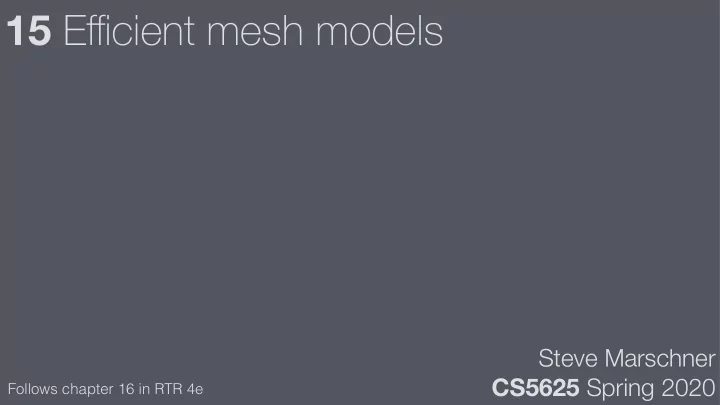

15 E ffi cient mesh models Steve Marschner CS5625 Spring 2020 Follows chapter 16 in RTR 4e
Basics of e ffi ciency for meshes Use triangle or quad meshes • general polygon meshes lead to too much complexity • quad meshes are great for some applications but more constrained Use shared-vertex triangle meshes for GPU applications • major memory/bandwidth savings over separate triangles • if you get separate triangles, merge them in a pre-process Store most data at vertices • there are ~half as many vertices as faces • vertex data may be interpolated across faces • in typical GPU mesh representation, vertices must be duplicated to create discontinuities
More sophistication in mesh storage Optimizing vertex order • strips and fans as examples (when per-frame bandwidth was the concern) • modern systems don’t use these but optimize for hit rate in vertex cache Reducing the number of triangles • ultimately this is needed to save more time and space • many levels of detail are useful - simpler meshes for faraway objects - simpler meshes for lower-resolution screens - simpler meshes for lower-performance hardware or networks
Vertex cache and mesh ordering Triangle strips gain e ffi ciency by caching the most recent two vertices • we are essentially using a FIFO cache policy with a size of 2 • cache miss rate approaches 1 miss / triangle
Optimizing for larger caches With indexed meshes, saving indices is less important • we store lots of data at vertices; ~6 indices is the least of our worries • just putting meshes in triangle-strip order gives you the same vertex caching behavior (“transparent” vertex caching) Newer systems are built with post-transform vertex caches • cache the results of the vertex processing stage • cache hits can save substantial computation As with other applications of caches, now order of data access matters
r is the average cache miss rate [Hoppe 1999]
[Sander et al. 2007 “Fast Triangle Reordering for Vertex Locality and Reduced Overdraw”]
Mesh simplification Many ways to simplify meshes • remove chunks, retriangulate hole • quantize vertices to centers of voxels Particularly simple and e ff ective is edge collapses, or edge contractions:
Quadric Error Metric Edge-collapse simplification produces a sequence of meshes • each mesh has one fewer face • each is derived from the previous by a single edge collapse Key question: where to put the vertex after the collapse? • at first vertex? at second? at midpoint? • can choose location as the solution to an optimization
Where to put the new vertex? It depends on the mesh geometry: • one way to formalize: the new vertex should be close to the planes of the triangles around it before the edge collapse
Garland & Heckbert QEM A particularly convenient error metric: sum of squared distances to planes • each plane has an equation, can be represented as a 4-vector ( a , b , c , d ) with ( a , b , c ) components normalized • distance of a vertex v from the plane p is then the inner product p T v • squared distance from plane is in the form v T Mv for a 4x4 M (a quadric) • and better yet, the sum-squared distance from several planes is still in the form v T Qv
<latexit sha1_base64="CuIkw7Zzlgy9z1iFLE8caL2K53E=">ACmXicbVFb9MwGHUyLl2B0cHjXiwqUCegubRs5QExLg8T4mET6zap6SLH/bJZc5xgO9GqaD90/4J/AHayTQPxSZbOd/5fDlOCs6U9v0rx125d/Bw85q9HjJ2tPe+vPDlVeSgpTmvNcHidEAWcCpDseFBJIlHI6S8y+2f1SBVCwXB3pZwDwjp4KljBJtpLinoq/ANRlEVbWJX3ALY2DVnh9w8OGR1HXWqrq5ABH2X4cWGxNt0po8V3boPVZk21vWjnu9f3hJHjnb49wC8bvr8HWCAdDv6n+x1+oqb143VmLFjktMxCacqLULPAL/Sbl8FPMayI1oxwu1GpoCD0nJzCzEBMlDzusnoEr80ygKnuTRLaNyodydqkim1zBLjzIg+U/2rPi/3qzU6WReM1GUGgRtD0pLjnWObeB4wSRQzZcGECqZuSumZ0QSqs23dKNmsPamyjBPycz7zhJ5NLTcJGlHhOUlwvwzLmSXbytzFbmNU2C4zCcjG2CFoyCGzC5TfAwHAajob8/7u98bqNEHbSBXqABCtA2kG7aA9NEUVX6LfTcVbdDfeTu+t+a62ucz3zHP1V7o8/Xt7GoA=</latexit> QEM simplification With the error in the form of a quadric per vertex: • the matrix is easy to compute from the surrounding triangles • the error is easy to optimize. Given Q 1 and Q 2 belonging to a pair of vertices v 1 and v 2 , we simply sum the errors of the two vertices: ∆ ( v ) = ∆ 1 ( v ) + ∆ 2 ( v ) = v T Q 1 v + v T Q 2 v = v T ( Q 1 + Q 2 ) v • minimizing this error is a 4x4 linear system—very fast • algorithm - 0. compute Q s for all vertices, compute errors for all potential edge collapses. - 1. use priority queue to find smallest-error edge. Collapse it; update the neighboring Q s. - 2. repeat until mesh is small enough!
69k faces 1k faces surfaces of constant cost for reducing to 999 faces [Garland & Heckbert 1997 “Surface Simplification Using Quadric Error Metrics”]
Continuous level-of-detail: Progressive Meshes Key observation: edge collapse is invertible • just need to store (o ff sets to) the locations of the two new vertices Thus a sequence of edge collapses, reversed, is a representation for a mesh [Hoppe 1996 “Progressive Meshes”]
Progressive Meshes Store full representation, load various levels of detail • just load or transmit a prefix of the list of edge splits • can change level of detail smoothly depending on size/distance/salience/etc. Can interpolate (“geomorphs”) • sudden edge splits/collapses are jarring • interpolate new vertices from merged position to new positions • leads to truly continuous LoD Extra details (of QEM and PM) • boundaries, creases—want to preserve them • merging of small pieces—otherwise can’t simplify enough • maintenance of additional attributes—throw them in the metric too
[Hoppe 1996 “Progressive Meshes”]
[Hoppe 1996 “Progressive Meshes”]
Recommend
More recommend